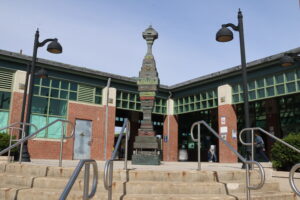By Michael Zavatsky
Editor’s note: The following is part six in a series on Long Island transportation.
As Paul Cirone of Franklin Square made his way to Broadway for a production of “Funny Girl” in the summer of 2023, his spirits were high as the traffic was light on the Northern State Parkway. Cirone, a 20-year-old college student at Hofstra University, is used to Long Island’s roads, as he grew up on them. “I’m basically driving every day,” he shared. “I know which roads to avoid most of the time.”
Despite his learned navigation skills, nothing could have prepared him for the pothole that cracked the sidewall on one of his tires. Cirone quickly found himself to be just another statistic, contributing to the widespread belief among Long Islanders that the roads are in disarray.
State and local roads across Long Island are utilized by more than 700,000 individuals daily. According to a 2024 report from TRIP, a national transportation research nonprofit, the constant poor condition of roads costs Long Islanders thousands of dollars annually in vehicle operating costs, crashes because of safety hazards, and lost time and gas owing to traffic congestion. In 2024 alone, drivers can expect to pay nearly $3,700 in repairs and wasted gas, according to the group.
“The worse shape roads are in, the faster a vehicle is wearing out,” said Rocky Moretti, director of policy and research at TRIP.
Though Moretti cites initiatives like the Federal Infrastructure Investment and Jobs Act of 2021 with providing more funding for federal transportation systems to address and repair roads that have fallen into disrepair, many projects are yet to begin, as “we have seen a significant increase [of 36%] in inflation and highway construction costs.”
The $1.2 trillion bipartisan investment in infrastructure and transportation spending left many on Long Island with the impression that the poor conditions of the region’s roads would soon be a thing of the past. Inflation, though, also plays a role in the reduced speed with which proposed infrastructure project proposals can be completed.
“I just don’t understand the lack of urgency,” Cirone said. “If I lost a tire on my new car, I would seriously consider driving less.”
According to Eric Alexander, executive director of the Northport-based Vision Long Island, there is a disparity between how towns and villages and the state government maintain the structural integrity of roads. Looking specifically at some of the state’s most dangerous roads such as Hempstead and Jericho Turnpikes and Sunrise Highway, “The biggest problem is the New York State Department of Transportation … Their biggest obstacle is embracing traffic and road solutions,” Alexander said.
“The worse shape roads are in, the faster a vehicle is wearing out.”
Rocky Moretti, director of policy and research at TRIP
While crediting the state DOT with completion of different projects like installing countdown timers at pedestrian crossings and repainting crosswalks, Alexander said he believes the department does not effectively communicate with Long Island’s leaders, communities and residents to address their specific needs. Local governments at the town and village levels often expedite their road projects, as residents, experts and elected officials can readily voice their concerns, Alexander said. The DOT’s absence at these meetings and lack of a community outreach team are among his biggest concerns regarding road repair.
Highway maintenance crews monitor pavement conditions and make repairs “as soon as they develop,” state DOT spokesman Stephen Canzoneri said. Despite claims of inadequate maintenance, New York is in the third year of its five-year capital plan, which is “one of the most aggressive road and bridge renewal programs in the United States,” Canzoneri said. The $33 billion infrastructure investment plan is the largest of its kind in state history.
Goals of the Transportation Capital Plan include:
• Generating jobs to maintain the safety of the system.
• Keeping New York competitive by managing state infrastructure assets.
• Generating billions of dollars in new construction and economic growth by leveraging state resources.
• Reducing the impacts of future extreme weather events.
The plan includes several million dollars allotted to specific regions across New York State. For Long Island, the state plans to invest $268 million.
Christopher Gosley, a spokesman for Assemblywoman Michaelle Solages, a Democrat from Elmont, said he believes communication is one of the first steps in making Long Island roads safer and easier to travel on. “Coming together and convening on it on all levels of government is important,” Gosley said.
Solages highlights the effectiveness of internal communications in towns and villages by sponsoring initiatives across Assembly District 22 such as implementing parking permits for Floral Park residents near UBS Arena and increasing the sale of electric vehicles to boost emission reduction goals. Both are projects that have been touted by residents and local leaders in her district.
To improve road safety, Gosley said he is “always a big proponent of research, seeing what research and the data says.” Whether it be potholes, metal grates or hazardous conditions, especially for pedestrians and cyclists, Gosley believes that sharing information and concerns from the local to the state level is the only way to improve road infrastructure.
Although the state is more than halfway through its five-year Transportation Capital Plan, comparing this year’s TRIP report to its 2022 report, road conditions across the New York Metropolitan and Long Island regions have not improved, but are not getting worse.
According to the reports, from 2022 to 2024, there were no increases in Long Island residents labeling roads as “poor,” “mediocre,” “fair” or “good.” Across the state, the percentage of “good” roads increased by 2%, while every other category decreased by 1%. As for congestion, Long Islanders are reportedly now losing one less gallon per year, with the 2024 report stating residents will lose around 37 gallons each in traffic this year.
As Long Island roads are stagnant in their development, Alfonso Castillo, a transportation reporter for Newsday from Valley Stream, said, “It is less who is doing the work and more that the work is not being done at all.”








